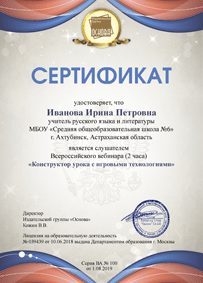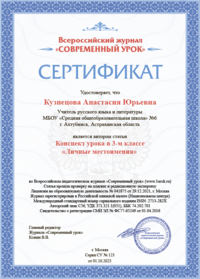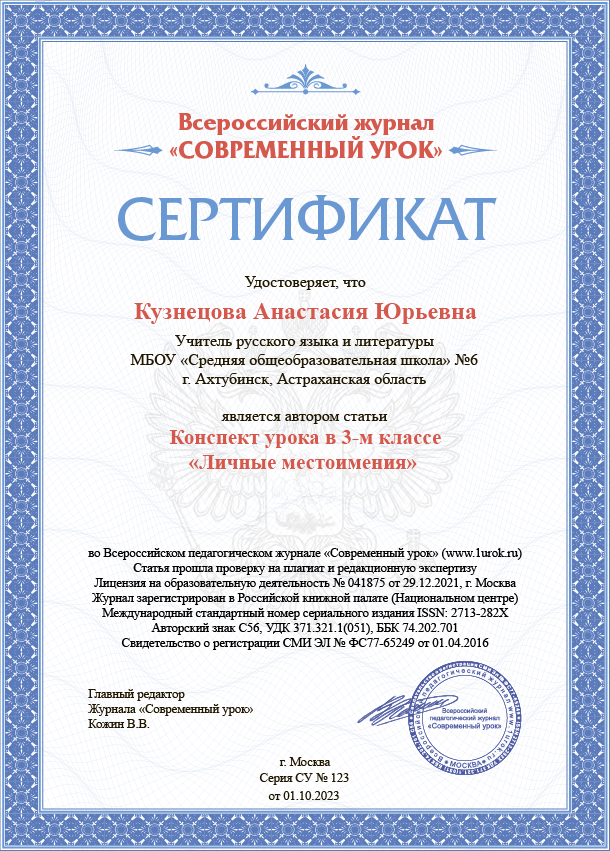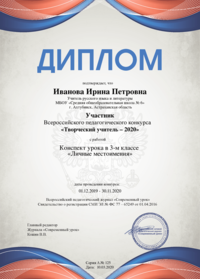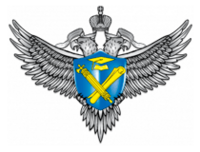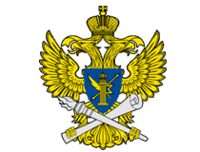Конспект урока ''What can a diary tell us about?'' (10 класс, базовый уровень)
Автор: Малышева Надежда Аркадьевна
Организация: МАОУ «Красногорская гимназия им.Н.И. Огородникова»
Населенный пункт: Удмуртская Республика, с.Красногорское
Планируемые результаты (цели урока по аспектам ИК):
личностные результаты (воспитательный и социокультурный аспекты ИК):
воспитательный аспект — осознание общечеловеческих гуманистических и демократических ценностей; воспитание уважения к героическим страницам в истории Отечества.
социокультурный аспект - знакомство со страницами жизни Анны Франк; знакомство с событиями, связанными с Блокадой Ленинграда.
метапредметные результаты (развивающий аспект ИК):
регулятивные — умение самостоятельно определять цели деятельности; умение самостоятельно осуществлять, контролировать и корректировать деятельность, использовать все возможные ресурсы для достижения поставленных целей и реализации планов деятельности, выбирать успешные стратегии в различных ситуациях;
познавательные - умение ориентироваться в иноязычном письменном тексте, извлекать информацию на разных уровнях в соответствии с поставленной коммуникативной задачей; семантизировать слова на основе языковой догадки и словообразовательного анализа; умение интерпретировать языковые средства, отражающие особенности иной культуры; коммуникативные — умение ясно, логично и точно излагать свою точку зрения, использовать адекватные языковые средства; владение языковыми средствами; планировать своё речевое поведение.
предметные результаты (учебный аспект ИК): умение читать аутентичные тексты с полным пониманием содержания;
сопутствующие задачи: развитие умений (монологичекая форма речи - рассуждение) распознавать и использовать ранее изученные грамматические явления, читать с целью понимания основного содержания, с целью полного понимания содержания и с целью извлечения конкретной информации, переводить, догадываться о значении неизвестных слов по контексту и по синонимам, выражать собственное мнение, извлекать культурологическую информацию, выполнять задания в тестовых форматах, составлять короткие тексты, используя ключевые слова. На протяжении всего урока идет постепенная работа с заранее подготовленной презентацией.
КОНСПЕКТ УРОКА
1. СЛАЙД 1 (с названием урока) Good morning to everyone! Glad to see you. Hope you are OK. Is anybody absent today? (отчет дежурного) Thank you. We have an unusual lesson today because there are some guests here. But don't worry, be active and hard-working as usually. Besides, don't forget to fill out the self-assessment cards during the lesson (см. в Приложении №4 ниже).
2. СЛАЙД 2 (one by one: иллюстрации с разными видами дневников) Now look at this slide, what does the word "diary" mean? (a special book where we can write our thoughts). What kind of diaries can we meet? (hints (подсказки): a school diary, traveler's diary, a scientific diary, a private or personal diary and a modern kind of diaries - blogging. So, what are we going to talk about? (about diaries).
3. What skills do you need for our work at this lesson? (примерные ответы обучающихся: communication skills, team/pair-working skills, problem-solving skills, self-assessment skills, reading skills, searching the information skills, creativity skills...
4. Last lessons we talked about events in the history of our country. Here are some important historical events (yellow paper; см. в Приложении №1 ниже). Choose those that can go together. Tick them right on this piece of paper. What is their theme? (2 minutes; all these statements are connected with the Siege of Leningrad - СЛАЙД 3 (блокада Ленинграда); зачитывают по очереди).
5. What do you know about the events related to the Siege of Leningrad, which are mentioned among the important historical events on the sheet of paper? For each pair you are given some key words on the pink paper. Make up some sentences (to create a short story) using these key words (см. в Приложении №2 ниже). (3 minutes)
6. It's time to listen to your stories.
СЛАЙД - ТЕКСТ (one by one; фото можно взять из интернет-ресурсов):
4 слайд - дорога жизни (иллюстрация + короткий текст)
5 слайд - блокадный хлеб (иллюстрация + короткий текст)
6 слайд - метроном (иллюстрация + короткий текст)
7 слайд - Ольга Бергольц (иллюстрация + короткий текст)
8 слайд - 7 симфония (иллюстрация + короткий текст)
9 слайд - дневник Тани Савичевой (иллюстрация + короткий текст)
Listen to the poem to understand Tanya's feelings better. Be ready to share your impressions.
+ видео о дневнике
(ссылка на видео https://yandex.ru/video/preview/10979821432702510097)
What adjectives can you use to describe your feelings? (sad, deep, exciting, hard...)
What period of our history is this diary related to?/ What kind of diary is it?
7. СЛАЙД 10 (на слайде фото Анны Франк и Тани Савичевой). Anne Frank's diary is also the striking document connected with that time. Read some facts about this girl and do the test below the text in pair (pink papers (см. в Приложении №3 ниже); 4 minutes; check the answers, looking at the slide: 1-F 2-T 3-T 4-N/S 5-F 6-T 7-T 8-F)
8. What do these girls have in common? (2 minutes; work in pairs; if it is necessary, write down the information in copybooks).
Предполагаемые ответы обучающихся:
- they began keeping the diary about at the same age;
- they were keeping the diary during the war;
- they both are victims of the war (the Nazis);
- only one member of the family survived (Anne - her father Otto, Tanya - her brother Michail);
- they died right before being freed.
Why did they keep their diaries?
(Tanya - "you need to keep the diary in order not to want to eat" - said the doctor;
Anne - she wants to show all kinds of things that are in her heart; besides, she wanted to become a journalist.
Probably, this way it was easier to overcome hunger and other difficulties of that period of their life).
9. I think there are those among you whose relatives also fought in the Great Patriotic War (Whose great-grandparents took part in this war?). If they could keep a personal diary, what would they write in it? (ответы двух обучающихся).
10. СЛАЙД 11 (на слайде фото Музейного центра "Патриот" в Москве, включая Музейный комплекс "Дорога Памяти") Our family also carefully keeps (cherishes) the memory of Malysheva Elena Petrovna, who was a sniper during the war. She graduated from the Central sniper school in Moscow (the same as Zoya Kosmodemyanskaya did). Of course, she didn't keep the diary. But If she had done it, she would have told about her combat friends, about successes at the front, about experiences and ,of course, confidence in coming victory (special memorial complex which suggest tourists to walk their 1418 steps to the victory; there is a huge wall where we could see the photo of our grandmother made up from the photos of other participants of the Great Patriotic War).
11. To sum up our work, WHAT CAN A DIARY TELL US ABOUT? ( ответы детей: about our thoughts, about our life experience, about our dreams, our achievements...).
12. Reflection: At the beginning of the lesson, we remembered many important dates from the history of our country. But this year is special for our Motherland. СЛАЙД 12 (фото, отображающее знаковую дату - 80-летие Победы) Why? (80th anniversary of the Victory in the Great Patriotic War).
СЛАЙД 13 Why should we remember such important events from our history? (any 3 opinions of students to answer:
1) The answer is simple. We need to know our country's history, our family's background and the traditions and customs of our people, to preserve and follow them. Then we can be good citizens and love our country and our ancestors.
2) Besides, there were a lot of bad things in history. We don't want them to happen again, that's why we must remember them).
13. Look at the blackboard and say which of these words we have used at the lesson today: a symbol, suffering, a diary, A PROMINENT PERSON, the symphony, important, difficulties, an anniversary, hard, survived, courage, feat. As a result the word combination A PROMINENT PERSON is left. But...
14. H/w: (СЛАЙД 14) Our school is named after The Hero of the Soviet Union Nikolay Ivanovich Ogorodnikov. I'm sure you can agree that he is A PROMINENT PERSON. What do you think he would write about if he addressed you, the current generation? The text is about 120 words.
15. The lesson is over. Thank you for taking an active part in it. Don't forget to give me your self-assessment cards.
ПРИЛОЖЕНИЕ
№1. Тексты с известными историческими событиями:
1) On January 27, 1945, the Auschwitz concentration camp was liberated by Soviet troops. This is the date of commemoration of the victims of the Holocaust.
2) On May 16, 2025, the 115th anniversary of the birth of Olga Fedorovna Bergolts, who was called the voice of besieged Leningrad, will be celebrated.
3) In 988, the baptism (Christianization) of Rus took place. The event is directly related to the name of Vladimir Krasnoe Solnyshko. (In 988 Russia was baptized. The name of Vladimir the Red Sun is connected with this event.)
4) The Tatar-Mongol invasion lasted 238/243 years from 1242-1236 to 1480. Of the 72 cities only 17 remained free.
5) During the war, and especially in besieged Leningrad, the sound of a metronome meant a heartbeat, it meant that life went on.
6) On February 19, 1861, Emperor Alexander II signed a manifesto on the abolition of serfdom in the Russian Empire, also known as the peasant reform.
7) The Road of Life operated from September 12, 1941 to March 1943.
8) The Patriotic War of 1812: the French troops entered the ancient capital of Moscow on September 14, 1812, but it was burned down.
9) Tatiana Nikolaevna Savicheva (01/25/1930 - 07/01/1944) was a Soviet schoolgirl who kept a diary in her notebook since the beginning of the siege of Leningrad.
10) On May 9, 1945, Soviet troops defeated Nazi Germany. This year we are celebrating the 80th anniversary of Victory Day.
11) The 18th century: Peter the Great laid the foundation of the Russian Empire.
12) On August 9, 1942, a performance of Shostakovich's 7th Symphony took place in the crowded hall of the Leningrad Philharmonic.
13) 1991 was the year when the USSR ceased to exist.
14) The siege of Leningrad, which lasted 872 days, was lifted on January 27, 1944.
15) The Great Patriotic War: the battle of Stalingrad, where the Soviets defeated the German 6th Army, was the turning point for the war on the Eastern Front.
16) The blockade bread was a symbol of how strong and brave the people who defended the city were.
№2. Слова для работы в группах:
1) The Road of Life: the only, Lake Ladoga, from September 12, 1941 to March 1943, 46 kilometers, delivered, were taken out of the city
2) The blockade Bread: a special recipe, hard, on bread cards, coped, the difficulties, 125 grams per day
3) A metronome: loudspeakers, the siege of Leningrad, a metronome, was tapping, to hide, sounded, 55 times per minute
4) Olga FyodorovnaBergolts: the 115th anniversary, the voice of besieged Leningrad, unknown poetess, synonymous with life
5) The symphony: Dmitry Shostakovich, the symphony, the score, a special plane, the crowded hall, was broadcast, loudspeakers, the enemy's guns, "Leningradskaya"
6) Tanya Savicheva: a symbol, the suffering, besieged Leningrad, the tragedy; kept a diary, the State Museum of History, reflected the fate
№3. Текст об Анне Франк (текст взят из старого банка заданий ФИПИ):
TRUE/ FALSE/ NOT STATED
Anne Frank was a Jewish girl who became famous after her death when her wartime diary was published.
Anne was born on June 12th, 1929 in Frankfurt, Germany to Otto Frank and Edith Frank. Anne was the youngest of two sisters. When the Nazis gained control of Germany and the danger to Jewish people increased, her family emigrated to the Netherlands. Anne was four at that time.
On May 10th, 1940, after the outbreak of World War II, German armies invaded the Netherlands. The danger was getting very close to the Jewish family. Soon Anne's older sister, Margot, got a note from the new authorities. She had to go to a German work camp. However, Margot did not obey. Instead, the Franks went to a secret hiding place which they had prepared beforehand.
They hid in a small annex, an extra building added to a house. Later Anne called it the Secret Annex. Together with the Franks, there were eight people in the Secret Annex. The entrance to the annex was hidden behind a moveable bookcase. While hiding, the Franks could not go outside. They had to stay quiet so that the neighbours did not guess that there was anybody in the annex. The Franks lived in constant fear of what would happen if they were discovered.
Anne started writing her diary on her thirteenth birthday. The diary would later be published as The Diary of Anne Frank. In her diary, Anne wrote about her thoughts, and about her life in the Secret Annex. Most of her diary was written in the form of letters to a person named Kitty. Anne also wrote short stories and collected quotes from other writers in her notebook. The girl had dreams of becoming a journalist or a writer.
The Franks spent 2 years in the Secret Annex. When Anne was 15 years old, the Secret Annex where they had been hiding was discovered. It is believed that someone betrayed them. On 4th August 1944, all those in the Secret Annex were arrested.
They were sent to Auschwitz, a concentration camp. It was a death camp. Anne was sent to the same barracks as her sister and her mother. Their father, Otto, was separated from his family, and never saw his daughters or his wife again. Anne and her sister survived several months in difficult conditions, working hard.
Later, Anne and her sister were sent to another concentration camp. Anne died there in March, 1945. She was only 15 years old. It is believed that she died of typhoid.
All the inhabitants of the Secret Annex, except Otto Frank, died in the concentration camps. He returned to Amsterdam and found the diary of his daughter. Two years later, in 1947, he published Anne's diary.
- book, The Diary of Anne Frank, impressed people a lot. There have been more than 30 million copies sold. It was translated into 67 languages and it was adapted for both the theatre and the cinema.
The address where Anne Frank and her family hid was Prinsengracht 263 in Amsterdam, the Netherlands. Now there is a museum (the Anne Frank House) where people can see the actual house she lived in while in hiding. Approximately one million people visit the Anne Frank House each year.
1) Anne was older than her sister, Margot.
2) The Secret Annex was not far from the house where the Franks lived in Amsterdam.
3) The Frank family shared their hiding place with other people.
4) Kitty was Anne’s cousin.
5) Anne Frank wanted to become an actress.
6) All the people who were hiding in the Secret Annex were arrested by the Nazis.
7) After the war, the book The Diary of Anne Frank was published in different languages.
8) The Anne Frank House museum is located in Germany.
№4. Карточки для самооценки (на каждого ученика):
self - assessments cards
|
1. |
finding out the events combined with the same theme |
|
|
2. |
reading for details (number - letter) |
|
|
3. |
answering the questions |
|
|
4. |
making up a short story using the given words |
|
|
5. |
comparing the diaries |
|
|
6. |
giving one's opinion |
|
final mark:
№5. Примерные тексты для слайдов по Блокаде Ленинграда:
1) The Road of Life is the only transport highway connecting besieged Leningrad with the country and passing through Lake Ladoga. Its length was 46 kilometers. With its help, food was delivered to the city and people were taken out of there. The road operated from September 12, 1941 to March 1943. (The Road of Life was the only way to get food to Leningrad. It went through Lake Ladoga and was 46 kilometers long. People used it to get out of the city. The road worked from September 12, 1941 to March 1943.)
2) Bread during the blockade, prepared according to a special recipe and given out on bread cards, was a symbol of how strong and brave the people who defended the city were. Their work was hard, but they coped despite all the difficulties of the war. The bread was bitter and 75% consisted of rye flour. The minimum amount you could receive per day was 125 grams. (It was made from 75% rye flour. You could get 125 g of bread a day.)
3) There were loudspeakers in the streets during the siege of Leningrad. When the radio program ended, a metronomesounded. It was necessary for people to know that the radio was working. If the metronome was tapping fast (150 times per minute), it meant that you had to hide, because there would be a bombing. And if it's slow (55 times per minute), then everything is fine, you can go out.
4) On May 16, 2025, the 115th anniversary of the birth of OlgaFedorovnaBergolts, who was called the voice of besieged Leningrad, will be celebrated. An unknown poetess who had never performed on the radio came to the radio committee in October, 1941 and offered her help. Her voice became synonymous with life in Leningrad. (On the 16th of May, 2025, we will celebrate the 115th birthday of Olga Bergolts. She was called the voice of Leningrad when it was besieged. In October 1941, an unknown poet came to the radio and offered her help. She never performed on radio before. Her voice was very important for people in Leningrad.)
5) Dmitry Shostakovich began his work on the symphony on July 19, 1941, back in Leningrad. In October, he and his family were evacuated to Kuibyshev. The score was delivered to besieged Leningrad by a special plane. On August 9, 1942, a performance of Shostakovich's 7th Symphony took place in the crowded hall of the Leningrad Philharmonic. It was broadcast on radio and loudspeakers. While the music was playing, the enemy's guns were silent. Anna Akhmatova called it "Leningradskaya." It reflects faith in victory, sacrifice, and boundless love for your city and country.
6) Tatiana NikolaevnaSavicheva (01/25/1930 - 07/01/1944) was a Soviet schoolgirl who kept a diary in her notebook since the beginning of the siege of Leningrad. The diary is kept in the State Museum of History in the city of St. Petersburg. Thanks to his older brother Mikhail, the notebook survived and became one of the mournful symbols of the Great Patriotic War. He reflected the fate of thousands of families who died in besieged Leningrad. (Tanya Savicheva was a young girl from Russia who kept a diary during the Second World War. The war took place in Leningrad, and Tanya's brother, Misha, saved her diary after she died. The diary is now in a museum in Saint Petersburg, and it tells the story of the death of many people during the war in Leningrad.) The doctor said: "To stop wanting to eat, you need to keep a diary."

